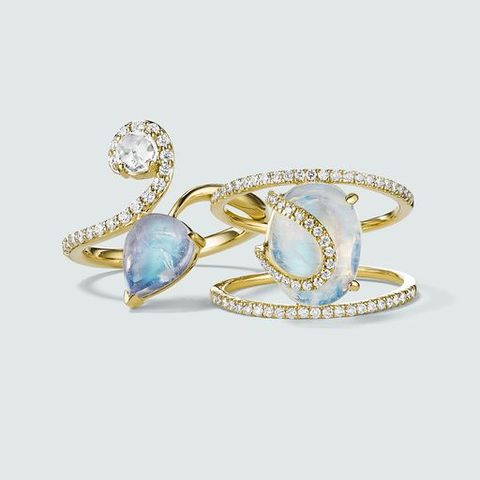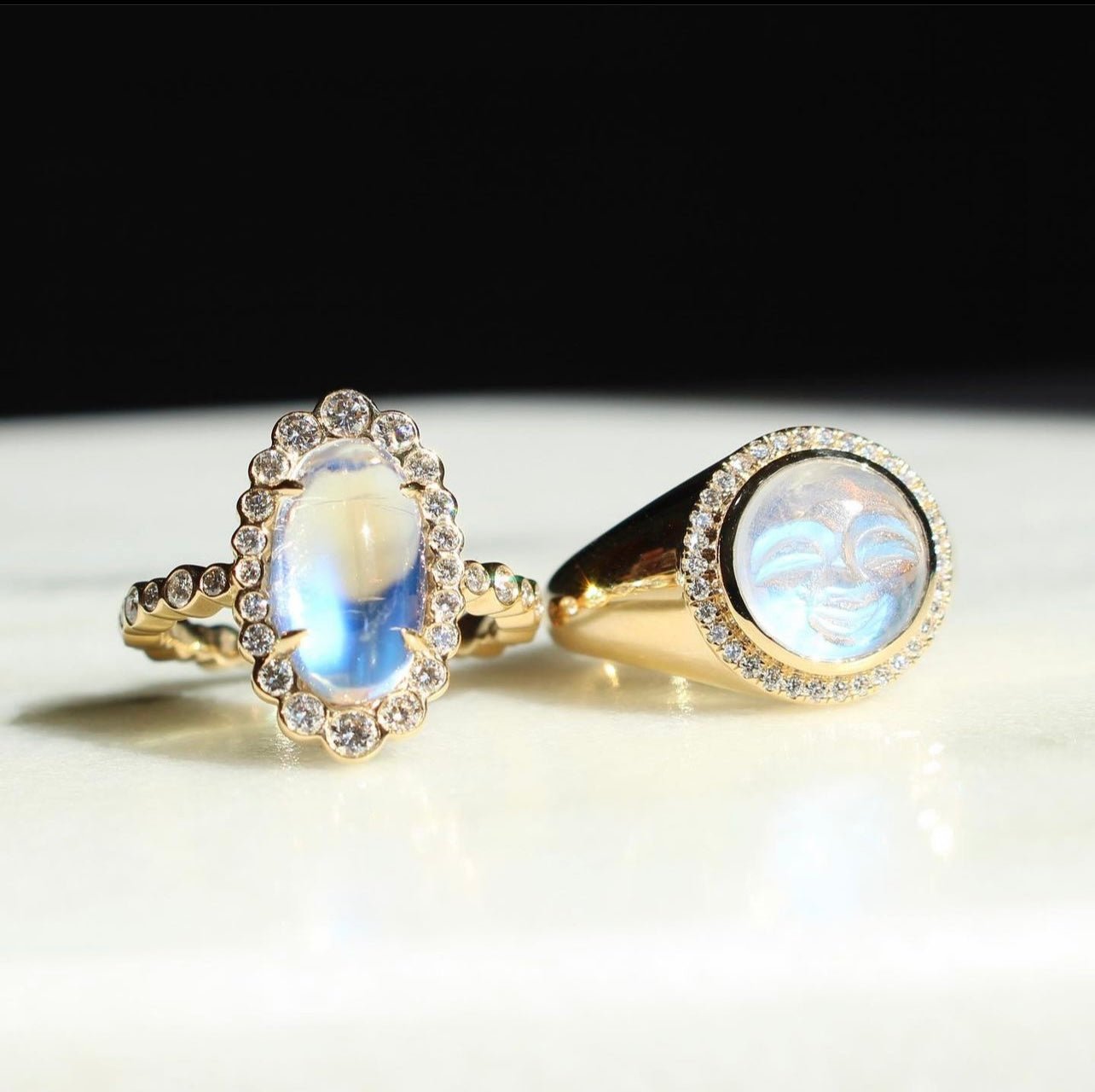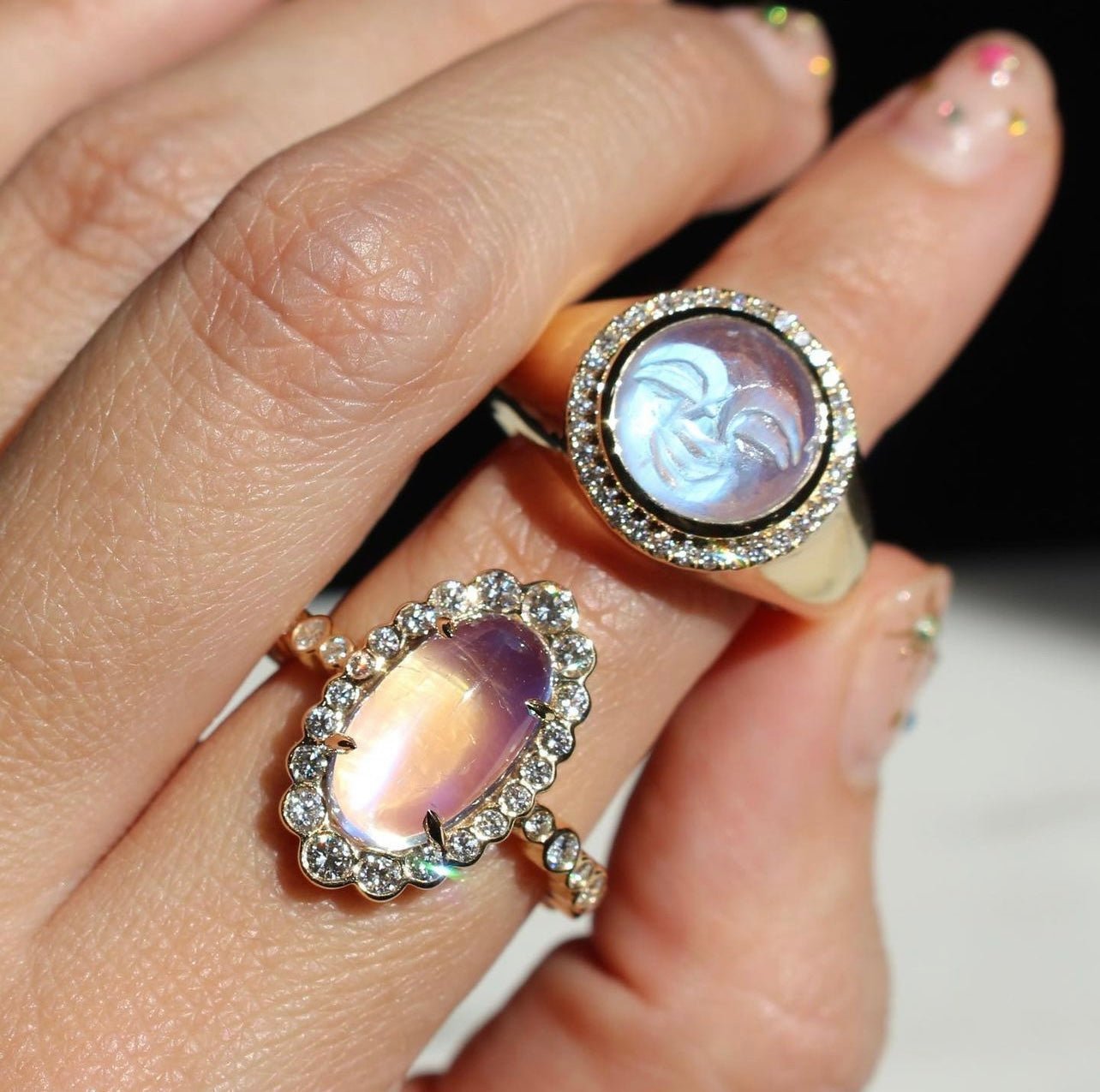As most gem collectors know, raw pieces are almost always far more valuable, durable, and worth investment than modified ones. Moonstone is no exception to this hierarchy. This makes it even more essential that consumers understand what they are purchasing, what moonstone may be inauthentic, and how to spot genuine pieces.
As the birthstone of June, a symbol of the moon, and one of the most interesting exotic gems, moonstone has so much to offer when it is left to its own devices and works its natural magic - a beautiful display of reflection, just like the moon!
A Brief History
Moonstone was first discovered in Mt. Adular, Switzerland and eventually was named by the Roman natural historian Pliny. He recognized that the stone mimicked the phases of the moon with its ability to shimmer in different levels of brilliance when turned. He hypothesized that this meant the gem was on the same timeline as the moon, following its phases in sync.
Aduliara is the root mineral of the common moonstone, which is named after and hails from Mt. Adular. Adularescence is the phenomenon defined by a light or glow that appears from within the gem. This glow is actually microscopic layers of feldspar inside the moonstone which fracture light and make it appear in different bursts.
If the feldspar layers are thin, they give off a blue sheen. Moonstone marked in this color is favored. Feldspar layers that are thick give off a white sheen, a closer replication to the moon.
Location Matters
Moonstone is found throughout the world, in varying degrees of value. Sri Lankan moonstone is some of the most transparent documented, with the desired blue sheen. Its rarity and fine quality has rendered it nearly extinct, most of it being mined over time.
The gem can be mined in India, Australia, Myanmar, Madagascar, and some places in the U.S. Myanmar moonstone was popular for its incredibly valuable, colorless, clear stones with blue sheens. In a similar story to that of Sri Lanka, the Myanmar supply has dwindled over the years and its rarity has made it a staple in secondhand auctions and unique dealers. Prices continue to rise for this gem.
Colors also vary due to where the stone originates. Southern India has a bright, “parrot green” body color offering that also contains adularescence. There is some yellow pleochromism inside, making it popular due to the trendiness of orange to yellow, peach-colored moonstones in fashion.
Raw Moonstone Markers
The properties of raw moonstone are distinct, making it easy to tell a genuine piece of the gem apart from a fraudulent one, visually. This simplifies the job of the consumer if they perhaps don’t have the time or money to hire a gemologist to review their purchase.
Moonstone is a combination of orthoclase, and has a monoclinic crystallography. It is known to naturally have different body colors, while the more colorless or blue-hued the more valued.
The colors range from green, yellow to brown, gray, to black. Iron content is what determines this body color, and iron oxide, goethite inclusions, are able to make the body color red.
General characteristics of raw moonstone include:
- Luster: Vitreous.
- Hardness: 6-6.5 on the Mohs scale.
- Fracture: Conchoidal.
- Heat Sensitivity: None.
- Enhancements: A dark coat on the back of the gem brings out more adularescence, but it is uncommon. Can be found with magnification.
- Pleochroism: Uncommon.
- Occurs in: Gravel, pegmatite.
The stone is also famous for its cat-eye effect, chatoyancy, which occurs in some raw pieces. Asterism can be found in other stones, an effect that includes four-rayed stars inside the stone. The finest form of moonstone is mostly transparent with no visible inclusion and the classic blue sheen. It can also be described as glassy looking.
Inclusions and Conclusions
Typically, inclusions are void from raw materials like gemstones. They mark the use of outside modification. However, moonstones are the exception to this rule.
Stress cracks are present in the raw gem, usually coming in pairs and running throughout the inside. They are created by fissure systems that come from exsolution pressures.
These cracks are nicknamed “centipedes” and are indicative of the likelihood of moonstone breaks and cracks. The gem itself is low on the Mohs scale and not very durable, the opposite of what one would expect from an untouched gem.
Additionally, any stress cracks or cavities in the gem can be spotted visually through dark areas. For this reason, moonstone can not be inspected for knock-offs on hardness alone. If you are looking to buy a pure stone for jewelry purposes, it is smart to inspect it for these hallmarks and proceed with caution if it will be a well-worn piece.
Whether natural or man-made, inclusions have the ability to get in the way of adularescence quality.
Has Your Stone Been Modified?
A good way to test if your moonstone has been worked on is to determine its value through traditional characteristics.
One of these is clarity. While this can be negatively impacted by naturally-occurring inclusions such as the tension cracks, methods like cabochon cutting are also harmful. This style that features a flat cut on the back of the stone reduces sheen. The best way to cut a moonstone to optimize brilliance is a faceted cut. This choice also hides any blemish-like inclusions.
If your piece has been carved, do not panic! This is a common practice for moonstone, as it heightens the aduralescent properties of sheen and makes the movement of light even more accessible.
Truly fine moonstone is small, with blue sheen pieces not exceeding 15-20 carats.
Meanings, Allure, and Lore
Moonstone is popular for its symbolism. Its rich history and vast expanse across the world in natural occurrences make it a perfect target for lore as well.
Man in the Moon
The moon is one such symbol that moonstone is typically associated with, for obvious reasons. Not only does the gem share a name with the satellite, but it mimics the shine and brilliance of the much larger rock. It is believed that the gems also symbolize love, protection, and fertility. This makes it a wonderful gift for those in a relationship.
However, “man in the moon” pieces that carve the face of the moon into a moonstone - or any variation of this - are typically not raw gems. The type of moonstone that best mimics that milky white of the moon is opaque, which represents a more common, less valuable, modified gem.
Long-Held Beliefs
Folklore suggests that exchanges of moonstone between partners when arguing can reinstate peace, rejuvenate love, and lower all remaining tension.
If you have recently hit a rough patch with a loved one, even a sibling or friend, giving them the gift of moonstone may help alleviate the issue altogether - or at least they’ll have a nice piece of jewelry!
We understand the deeper meanings that consumers hold regarding our gems, and that is why we included a moonstone, ruby, turquoise, set of earrings in our Valentine’s Day gift guide. The gems are set in 18k yellow gold with heart accents holding the moonstone itself, which is surrounded by diamonds.
No matter the holiday or event, Mark Henry Jewelry handcrafts our designs with an acknowledgement of gem lore compared with traditional beauty.
Caring for Your Piece
The low durability of raw moonstone makes it difficult to wear if you aren’t taking any necessary precautions. Protective settings are easy to request and almost required to reduce scratches, especially if it is being placed in a compromising position throughout the day - a good example is a ring that may get knocked around frequently.
Try your best to avoid hitting the stone on other surfaces as well as ultrasonic or steam cleaning. The stone itself is far too delicate for these procedures.
Using warm water with a small amount of soap is enough to pull out the brilliance of your stone after a good wear, and can be applied gently with a soft cloth or brush for desired effect.
Summary
Moonstone’s namesake is no coincidence. Hindu beliefs maintain that the sheen itself is an intertwining of moonbeams. With adularescence and a beautiful fragility, the gem has certainly earned its symbolic comparisons.
Moonstone has become a staple in Mark Henry Jewelry designs due to its rarity and our commitment to exotic gems. All of our stones are ethically sourced with exceptional processing and value in mind. It is our mission to bring the finest pieces to our customers without compromising quality or inciting any concern over whether or not we are using the rawest materials.
Our offerings feature incredible moonstone pieces. Search for your next statement piece with the Maria Collection, which ranges in design from skull-inspired necklace pendants to our bumble bee earriCollections – Mark Henry Jewelryngs, necklace, and ring.
We believe that exotic gems are a better choice than diamonds due to their distinctive and rare properties, and there is no better example of this than moonstone. Natural magic is best found in raw stones, which have little to prove and everything to model. Who wouldn’t want to show off an entirely unique piece, or gift it to your loved one?
Sources:
Moonstone Quality Factors | GIA
What is Moonstone Gemstone? Value, Price, and Color | Gem Society








Great article! I like how you mix Moonstone’s history, culture, and science. The information about its powers and uses is very interesting. Great job! For more information, do visit:- https://navratan.us/